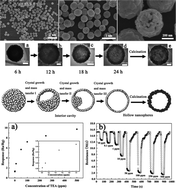Construction of monodisperse vanadium pentoxide hollow spheres via a facile route and triethylamine sensing property†
Abstract
Monodisperse vanadium pentoxide hollow spheres (VOHSs) were synthesized via a simple template-free solvothermal route followed by calcination in air. The as-prepared precursor and VOHSs were characterized by X-ray diffraction (XRD), Fourier transform infrared spectroscopy (FT-IR), scanning electron microscopy (SEM), transmission electron microscopy (TEM), high-resolution transmission electron microscopy (HRTEM) and X-ray photoelectron microscopy (XPS). Diameters of these VOHSs are in the range of 500–550 nm with a shell thickness of 55 nm. Building blocks of the hollow spheres are nanoplates with widths of 50–80 nm and lengths of 70–120 nm. The precursor hollow spheres gradually formed from solid spheres, to yolk–shell structures and to hollow spheres. Vanadium pentoxide based hollow sphere film sensors were fabricated via in situ solvothermal deposition and exhibited excellent sensing performances for triethylamine with an extra low detection limit of 10 ppb and good selectivity. The selectivity of the sensor might be due to the reduction of V5+ ions to V4+ ions when the VOHSs are exposed to triethylamine. The VOHSs are a potential candidate for trace triethylamine detection.


 Please wait while we load your content...
Please wait while we load your content...